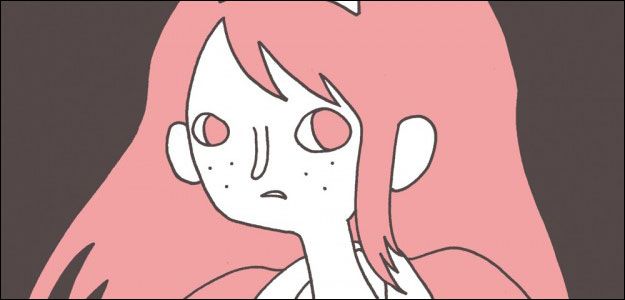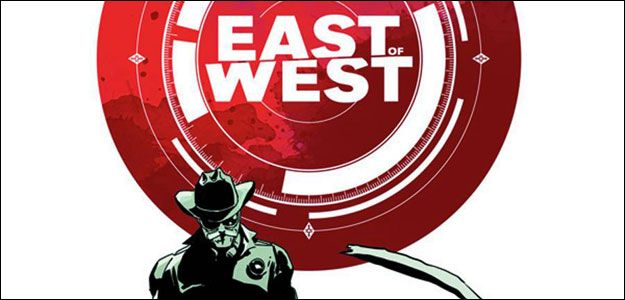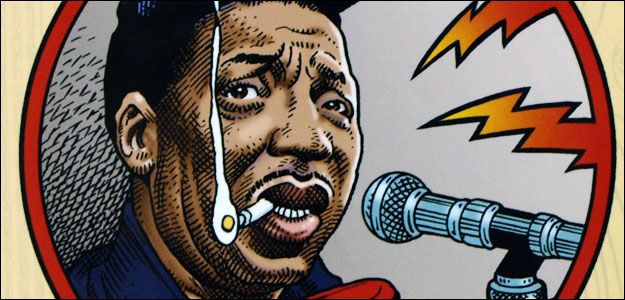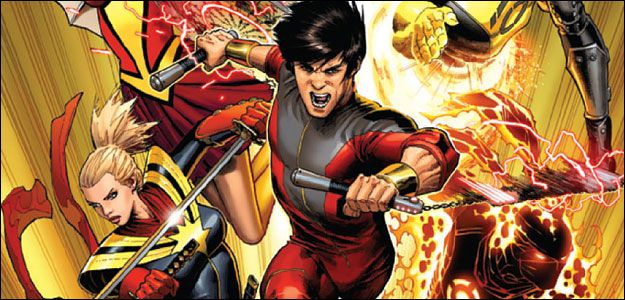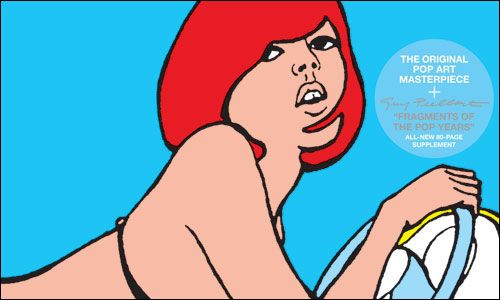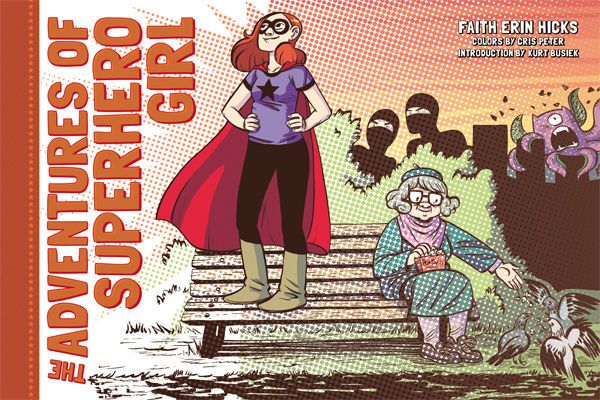Happy Mother's Day and welcome to What Are You Reading?, our weekly look at the comics, books and what have you we've been checking out lately. Joining us today is Allison Baker, co-publisher of Bandette, Edison Rex and all the other Monkeybrain Comics you can find on comiXology.
To see what Allison and the Robot 6 crew have been reading, click below.
*****
Michael May
I've been catching up on some comics from a week or two ago, starting with Jonathan Hickman and Nick Dragotta's East of West. I'm pretty sure this is my first Hickman comic, so I didn't know what to expect, but I was a little frustrated by the lack of any character worth rooting for in the first issue. There were some very cool characters and some compelling mysteries and developments though - and the world Dragotta presents is awe-inspiring - so I came back for the second issue. I don't know that I'm actually rooting for any of the characters yet, but I'm softening towards the personification of Death, which is an interesting development. I'm definitely in for more.
I wrote a while back about how Machine Man's support of Betty Banner is a huge source of enjoyment for me in Red She-Hulk. In the most recent issue, #65, Betty gets to return the favor and that's just as nice. And since I'm catching up on comics that I've featured in Why You Should Be Reading, it was wonderful to see FF #6 devoted to Darla Deering, my favorite character from that series. Ant-Man continues to prove himself a capable badass too, which is delightfully surprising to me.
Finally, I passed up Sesame Street #1 when it came out a couple of week's ago, because I imagined its being more kid-focused than I wanted. I love kid-friendly comics, but I don't buy them unless I'm reasonably sure that I can enjoy them too. I was afraid that Sesame Street would have as many educational and activity pages as story pages, so I didn't give it a shot. But then I saw the variant cover with Super Grover, Elmo, and Big Bird reading comics outside of a shop with my local store's logo in the window. It was too cute to pass up, so I flipped through it and was immediately impressed with the art (including a claymation-style Ernie and Bert strip) and lack of activity pages. It's all story and it's all adorable. Very much like the best parts of an episode of Sesame Street.
Chris Mautner
Legends of the Blues by William Stout (Abrams) — There's basically two people that will be interested by this book. Blues fans and Stout fans. The book might also appeal to fans of Robert Crumb's Heroes of the Blues trading card series that Kitchen Sink put out back in the day (and that Abrams collected as R. Crumb's Heroes of Blues, Jazz and Country. Stout apes Crumb's format completely (the series was originally intended as a sequel set of trading cards), right down to the extensive use of cross-hatching. But Stout is not Crumb and there's a bit of disconnect in seeing a talented but very different artist so consciously ape someone else. As a blues fan, I enjoyed the book (it comes with a nice compilation CD) and Stout's short biographies of the artists were concise and informative — there's a number of musicians here I'm not familiar with and will have to check out. But I kind of wish Stout had felt the freedom to do these portraits in his own style (the cover image of Muddy Waters teases at what might have been) than basically do a Crumb redux.
The Cartoon Book of Statistics by Grady Klein and Alan Dabney — I'm about as good with math as I am at dental surgery, so I approached this book with some trepidation and the hope that it would indeed be able to provide some insight into the scary world of statistics. For the most part it does that job very well. Adopting the Larry Gonick style of cartooning (info dumps offered in a friendly, casual prose with lots of visual jokes and asides), Klein and Dabney break down why statistics are important and how they work in a relatively easy to swallow manner, saving all the math stuff for an appendix in the back of the book. I didn't completely understand every formula or analogy thrown at me — a few went over my head — but I walked away with a better understanding of how Nate Silver and his entourage do their jobs. I plan on passing it on to my kids before they start taking those treacherous honors high school math courses.
The Case of Charles Dexter Ward, adapted by I.N.J. Culbard — I'm not a fan of H.P Lovecraft — sacrilege, I know. I've attempted to read his stuff a number of times and always found his prose to be dull and overly wordy and walked away before even getting the slightest chill down my spine. So it's no surprise perhaps to say that this adaptation of Lovecraft's novel didn't really thrill me, though it didn't bore me either. Culbard's got a nice, cartoonish style and his use of color (all blues and greens) go a long way to helping to set the eerie mood. Basically Culbard's rendition helped make Lovecraft palatable for me, though I doubt I'll go seeking out any more Cthulhu mythos stories any time soon. It was basically a pleasant way to kill a few hours on a Sunday afternoon. If that's not the gushing accolade Lovecraft fans would like, well, at least it's not a complete slam either.
Tom Bondurant
I'd like to start off this week by making an observation which someone, somewhere, has probably made before, and more intelligently, because it's about a 51-year-old comic book -- but as I understand it, that's why we have the Internet.
So most of The Incredible Hulk #1 (by Stan Lee and Jack Kirby, with inks by Paul Reinman, which I read after finally getting the first Essential Hulk) uses some form of the classic nine-panel grid. There are some deviations, but by and large every page has three tiers ... and each one of those tiers could function as its own comic strip, with its own setup and "punchline." Again, this is probably something Jack Kirby did all the time, but I just now noticed it, and it blew my mind. Comic books were originally repurposed from comic strips, of course, but I never really thought of Kirby in a "newspaper" context, since he spent so much time in comic books. Along the same lines, I have read a lot of Kirby comics, and this sort of three-panel rhythm never jumped out at me before. Now, it's hard to ignore. It really propels the story, too, because each tier's payoff just keeps leading into the next. It almost establishes a steady tempo for the issue, which just keeps things bopping along.
As for more current comics, Avengers #11 (written by Jonathan Hickman and drawn by Mike Deodato) was a fun caper story. It might have been a little too pleased with itself, but the party-friendly AIM operatives were fun enough to not be obnoxious, and Hickman wisely chose to focus on the very cool Shang-Chi. In fact, Mike Deodato's style has developed in the years since I last read him regularly (in the mid-'90s Wonder Woman), and today his clean, open look reminds me of Paul Gulacy. It's a different kind of story than previous issues' universes-colliding adventures, but it opens the door to what could be a nifty new arc.
Finally, with the 12-part "Zero Year" kicking off next month, it may not be the best time to mention that Scott Snyder has written some nice one- and two-issue stories for Batman. Issue #20 features regular artists Greg Capullo (pencils) and Danny Miki (Inks) showing Batman taking on a version of Clayface who not only mimics people's appearances, he steals their lives. Naturally, coming after Bruce Wayne puts Batman's secrets in danger, but it's resolved with a bit of misdirection that -- like so many Batman secret-ID perils which have come before -- really strains the predictive power of Occam's Razor. Still, that's the great thing about superhero comics: the less-likely explanation could easily be the answer. Capullo and Miki are great at making this Clayface truly monstrous without turning him into some kind of '90s-extreme villain. Much of this comes from his two sets of teeth, which amp up the creep factor appreciably. Overall, this was a fine couple of issues which show that a lot can come out of a little.
Mark Kardwell
Finally got my hands on a copy of Fantagraphics' big ol' new edition of The Adventures of Jodelle by Guy Peellaert & Pierre Bartier. What a great book. Worth getting just for the essays and biographical sections in the back end, the equal of any Phaidon-esque art publication, never mind the stone-classic ultra-influential comic at the front. I've spent more and more time this year writing about the interplay between comics, fine art and illustration, and this book represents something of a key moment in that relationship. And even if you're not as concerned with these matters as me, check it out because it looks great, is frequently very sexy, and often downright hilarious. Can't wait to see how Fanta repackage Peellaert's Pravda next.
Allison Baker
Full disclosure. I haven’t been asked to write about something I’ve read since college and I’m not a professional writer like my partner in crime, Chris Roberson, so this may or not be a) informative or b) entertaining.
Just want us all to be on the same page.
Yes. I like puns.
Right. What am I reading?
I’m in this crazy awesome book club chock full of comics professionals which is just ANOTHER reason Portland, OR is the best place EVER. We pick a prose book by vote and meet every few months to eat, drink and talk about the book we’ve all read. So I literally just finished reading A Visit From The Goon Squad by Jennifer Egan, the most recent pick. I wasn’t sure about this book when I first started it. The narrative structure is atypical which took a while for me to get comfortable with, but once I got a few chapters in, I got it. It was described to me by a fellow book clubber, to be about the music business, and more specifically about the early days of punk, etc… and it certainly is about that but only on the surface.
Underneath, it’s about the relationship threads created as we live, age, change, evolve and how we can be literally connected to people by circumstance or experience and friends in common for years without knowing it. Beginnings, endings, memories, time and believe it or not, the power of social media.
It hit home on a number of levels and I would definitely recommend giving it a shot. This is a book that makes you reflect on your own life, choices and path, which is quite remarkable if you think about it.
Okay next, COMICS!
I read a lot of comics on a regular basis but due to the time constraints of life, the vast majority of them are books I’m publishing or something my husband has written. So, instead of me giving you a laundry list of Monkeybrain titles that YOU SHOULD BE READING TOO, or talking about how great my husband is, cause frankly you already know that, I pulled a few things off the shelf just to write this piece, of which there are many, many, many books to choose from.
Nurse Nurse by Katie Skelly was delightful. I love reading things that are imaginative, funny and weird. This is a book that does all of that and more. I also read The Adventures of Superhero Girl by Faith Erin Hicks. I highly recommend this book and agree wholeheartedly with the protagonist that not every super hero has to have a dark tragic origin story. A very funny well done collection.
Then I wanted to find out what exactly was so great about Hawkeye so I read issue #2 by Matt Fraction and David Aja and boy howdy. What a great book! More of this please Big 2 or anyone really! I’ll be reading more.
Lastly I want to recommend High Crimes by Chris Sebela and Ibrahim Moustafa. Yes I publish this book and I know a mother shouldn’t have a favorite child but if I had to, this would be my favorite son. I read it as soon as it hits my inbox. Lucky for you issue #3, which I have already read of course, comes out this Wednesday. Yippee!

